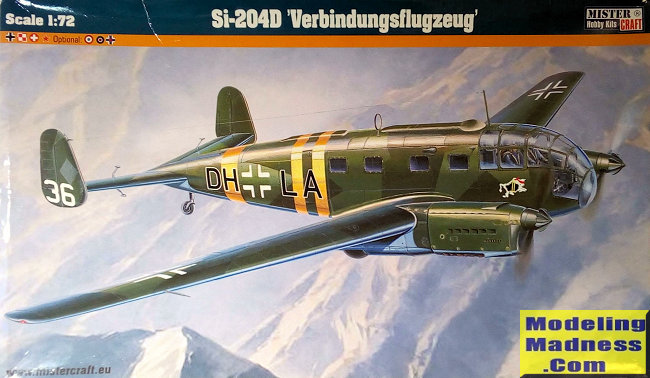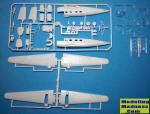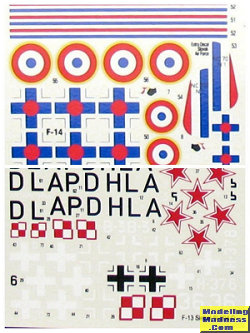Mistercraft 1/72 Siebel Si-204D
|
KIT #: |
F-14 |
|
PRICE: |
Around €15 |
|
DECALS: |
One option |
|
REVIEWER: |
Spiros Pendedekas |
|
NOTES: |
Reboxed KP kit |

The Siebel Si 204 was a small twin-engined transport and trainer aircraft
developed in World War II. Based on the Fh 104 Hallore, it was planned as a
small all-metal passenger aircraft for Deutsche Luft Hansa with two crew and
eight passengers. With development initiating in 1938, the plane was
redesigned as a trainer with a full "stepless" glass cockpit after the
beginning of WWII .
Whereas the first two prototypes were delivered as passenger aircraft with
the old cockpit, the third was delivered as a trainer aircraft for blind
flying, with its maiden flight taking place not earlier than the end of 1941
or the beginning of 1942.
Since Siebel by that time was too busy producing the Junkers Ju 88 under
license, only 15 prototypes machines were built in its Halle factory, with
production of various versions shifted to French Société Nationale de
Constructions Aéronautiques du Nord (SNCAN) and Czechoslovakian
Českomoravská Kolben-Daněk (ČKD) and Aero Vodochody factories.
The type was mainly used in advanced flying schools, communications
squadrons, flying services for senior officers and in the FÜG 1 delivery
wing of the Luftwaffe. It was likely the last German aircraft being shot
down on the Western Front on May 8, 1945 by a P-38 Lightning.
After the war, production continued in Czechoslovakia and France, with 179
and (est.) 340 examples respectively produced. Captured Si 204s flew in a
variety of civil roles in the post-war USSR.
Together with the post war variants, total production of this less sung but
nevertheless important and sufficiently performing plane in a variety of
tasks, was around 1735 units, the prototypes included.
 This
kit was first introduced by KP in 1976 as Aero C-3, then reboxed (updated
with new parts) after around 20 years by Flugzeug as Si-204D and from then
onward is regularly reboxed as Si-204D, Si-204A or Aero C-3 by mostly KP/Kopro,
Mastercraft, Mistercraft and Smer, which, I believe, are “cousin” companies,
with occasionally new or updated parts and decals and revised instructions.
In total this venerable mold has been reboxed more than 30 times(!). My
specific copy was the Mistercraft Si-204D 2018 edition, bought in 2022 from
one of my usual Hobby Shops in Athens in the old-fashioned (beloved) way,
i.e. “go there, have nice, teasing modeling talks, grab the kit and pay
cash”.
This
kit was first introduced by KP in 1976 as Aero C-3, then reboxed (updated
with new parts) after around 20 years by Flugzeug as Si-204D and from then
onward is regularly reboxed as Si-204D, Si-204A or Aero C-3 by mostly KP/Kopro,
Mastercraft, Mistercraft and Smer, which, I believe, are “cousin” companies,
with occasionally new or updated parts and decals and revised instructions.
In total this venerable mold has been reboxed more than 30 times(!). My
specific copy was the Mistercraft Si-204D 2018 edition, bought in 2022 from
one of my usual Hobby Shops in Athens in the old-fashioned (beloved) way,
i.e. “go there, have nice, teasing modeling talks, grab the kit and pay
cash”.
The kit comes in a relatively large good quality top opening box featuring a
very attractive box art of a Lutwaffe bird, flying over a snowy mountainous
landscape. Upon opening the box, I was greeted with 51 almost white styrene
parts, arranged in two equally sized sprues. One of the sprues holds the
four wing halves, whereas the other sprue holds all the rest. Molding is old
fashioned with thick sprue gates, with the molds showing their age as there
is quite a bit of flash that has to be cleaned and also some minor mold
imperfections which have to be attended to. Panel lines are, of course,
raised all over, tad on the heavy side, but looking good.
The cockpit is quite well appointed for the kits old origins, as it features
seats, yokes, instrument panels, rudder pedals, front and rear bulkheads and
some side panel details, all on the simplistic side, but, at least, there.
There is no passenger interior to speak of, but, nevertheless, no part of it
would be visible through the small windows.
Props look acceptable and the same can be said for the engine nacelles, but
their intakes lack depth. Landing gear is passable, but the bays are
non-existing, again, something to be expected.
Clear parts are a pleasant surprise, as they do not seem to come from the
original molds, but are of a more recent design, being well molded, clear
and not too thick.
Instructions are well done, provided in color as a folded A3 paper,
containing a short history of the type, a parts list, with the construction
spread in 9 steps. The seven of the above steps are simple, whereas the rest
two are more complex and contain a number of sub-steps. Each step or sub
step carries a description of what is dealing with, together with color
callouts where applicable.
 No less
than nine schemes are provided, for two Luftwaffe, two Swiss, a Slovak, a
Soviet and an English Si-204 (the latter two captured) and also for a Polish
and a French NC-701. Decals look very well printed and are expected to
behave very well.
No less
than nine schemes are provided, for two Luftwaffe, two Swiss, a Slovak, a
Soviet and an English Si-204 (the latter two captured) and also for a Polish
and a French NC-701. Decals look very well printed and are expected to
behave very well.
Instructions want you to first assemble the cockpit, then the engines,
followed by slicing in half the molded “shut” gear doors (meaning that a
“gear-up” option might be possible, though not mentioned in the
instructions).
The wings are next assembled, followed by the first “multi-step”, which
contains the sub-steps of fuselage assembly and attachment of wings, tail
planes, engines, front canopy and side windows.
The main landing gear is finally assembled and attached, together with some
(optional) bombs, for what looks to be a relatively uncomplex build (but,
bear in mind that “uncomplex” might not always mean “uncomplicated”,
especially taking into account the old kit origins and well used molds which
might present some degree of difficulty in putting the model together).
This is your prime candidate upon thinking of old fashioned, venerable kits,
General shape looks good as does the cockpit detail with the newer mold
transparencies looking even better! Instructions are nicely updated and the
decals look superb in both terms of variety of schemes offered and of print
quality. The lack of passenger interior is not a real minus, as,
practically, is invisible. What is evident, though, is the fact that the
molds start to show their age with the amount of flash and some spotted
imperfections, nothing too serious, though.
The kit is offered at sensible prices and can be found even cheaper on
occasional offers.It builds quite well and can result in a gorgeous looking
bird, like our Editor’s build in
1997. Still your only 1/72 option of this important plane, it is an old mold
but solid kit, from which an attractive representation of this important
plane can result.
Happy modeling!
Spiros Pendedekas
May 2022
Copyright ModelingMadness.com. All rights reserved. No
reproduction in part or in whole without express permission.
If you would like your product reviewed fairly and fairly quickly, please contact the editor or see other details in the
Note to
Contributors.
Back to the Main Page
Back to the Review
Index Page
Back to the Previews Index Page


 This
kit was first introduced by KP in 1976 as Aero C-3, then reboxed (updated
with new parts) after around 20 years by Flugzeug as Si-204D and from then
onward is regularly reboxed as Si-204D, Si-204A or Aero C-3 by mostly KP/Kopro,
Mastercraft, Mistercraft and Smer, which, I believe, are “cousin” companies,
with occasionally new or updated parts and decals and revised instructions.
In total this venerable mold has been reboxed more than 30 times(!). My
specific copy was the Mistercraft Si-204D 2018 edition, bought in 2022 from
one of my usual Hobby Shops in Athens in the old-fashioned (beloved) way,
i.e. “go there, have nice, teasing modeling talks, grab the kit and pay
cash”.
This
kit was first introduced by KP in 1976 as Aero C-3, then reboxed (updated
with new parts) after around 20 years by Flugzeug as Si-204D and from then
onward is regularly reboxed as Si-204D, Si-204A or Aero C-3 by mostly KP/Kopro,
Mastercraft, Mistercraft and Smer, which, I believe, are “cousin” companies,
with occasionally new or updated parts and decals and revised instructions.
In total this venerable mold has been reboxed more than 30 times(!). My
specific copy was the Mistercraft Si-204D 2018 edition, bought in 2022 from
one of my usual Hobby Shops in Athens in the old-fashioned (beloved) way,
i.e. “go there, have nice, teasing modeling talks, grab the kit and pay
cash”. No less
than nine schemes are provided, for two Luftwaffe, two Swiss, a Slovak, a
Soviet and an English Si-204 (the latter two captured) and also for a Polish
and a French NC-701. Decals look very well printed and are expected to
behave very well.
No less
than nine schemes are provided, for two Luftwaffe, two Swiss, a Slovak, a
Soviet and an English Si-204 (the latter two captured) and also for a Polish
and a French NC-701. Decals look very well printed and are expected to
behave very well.